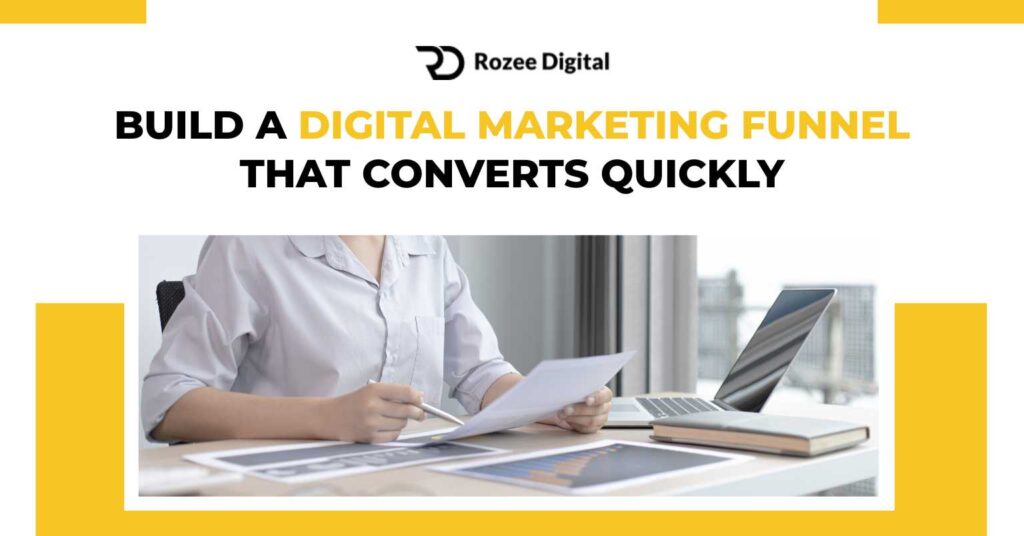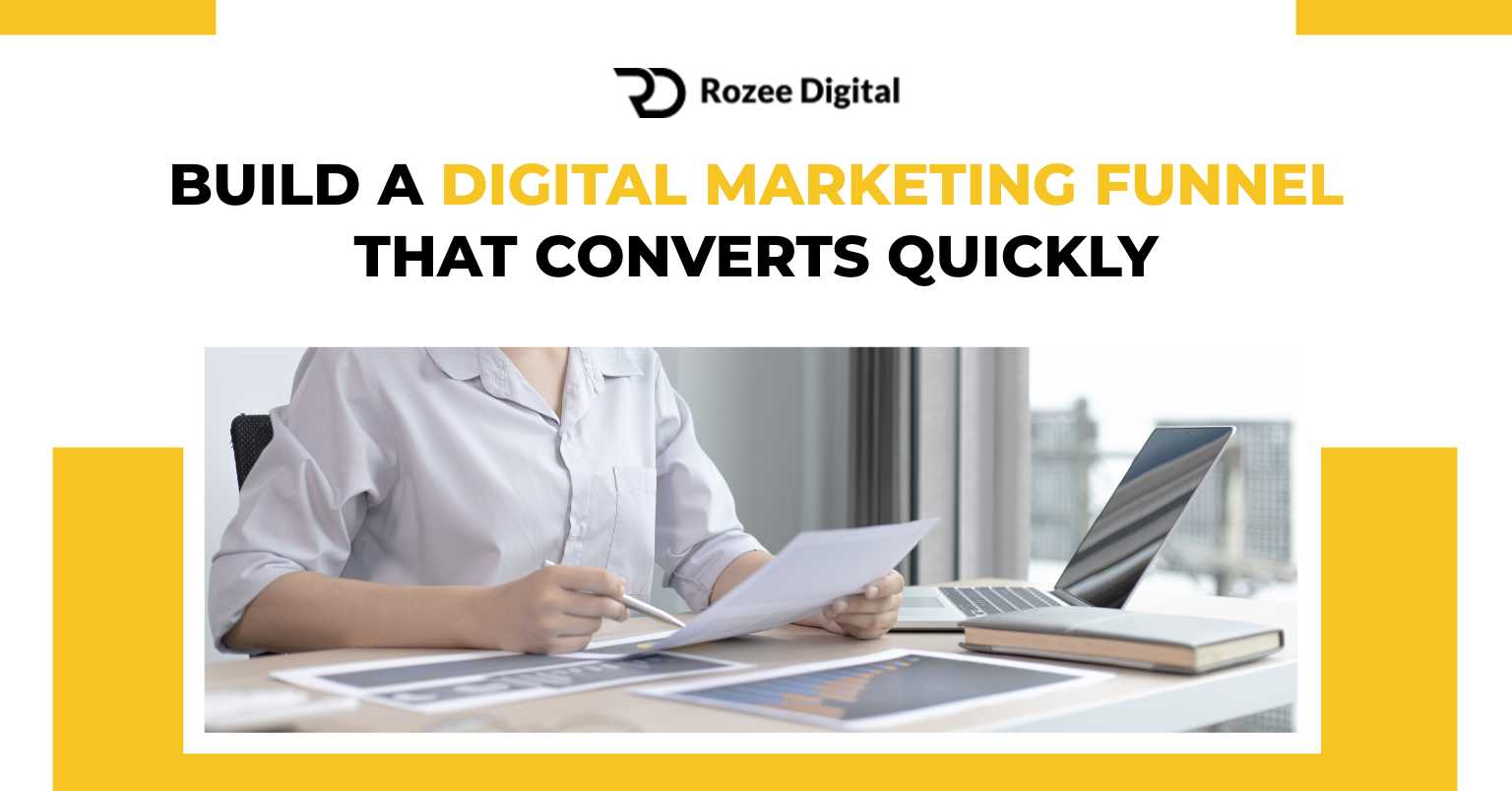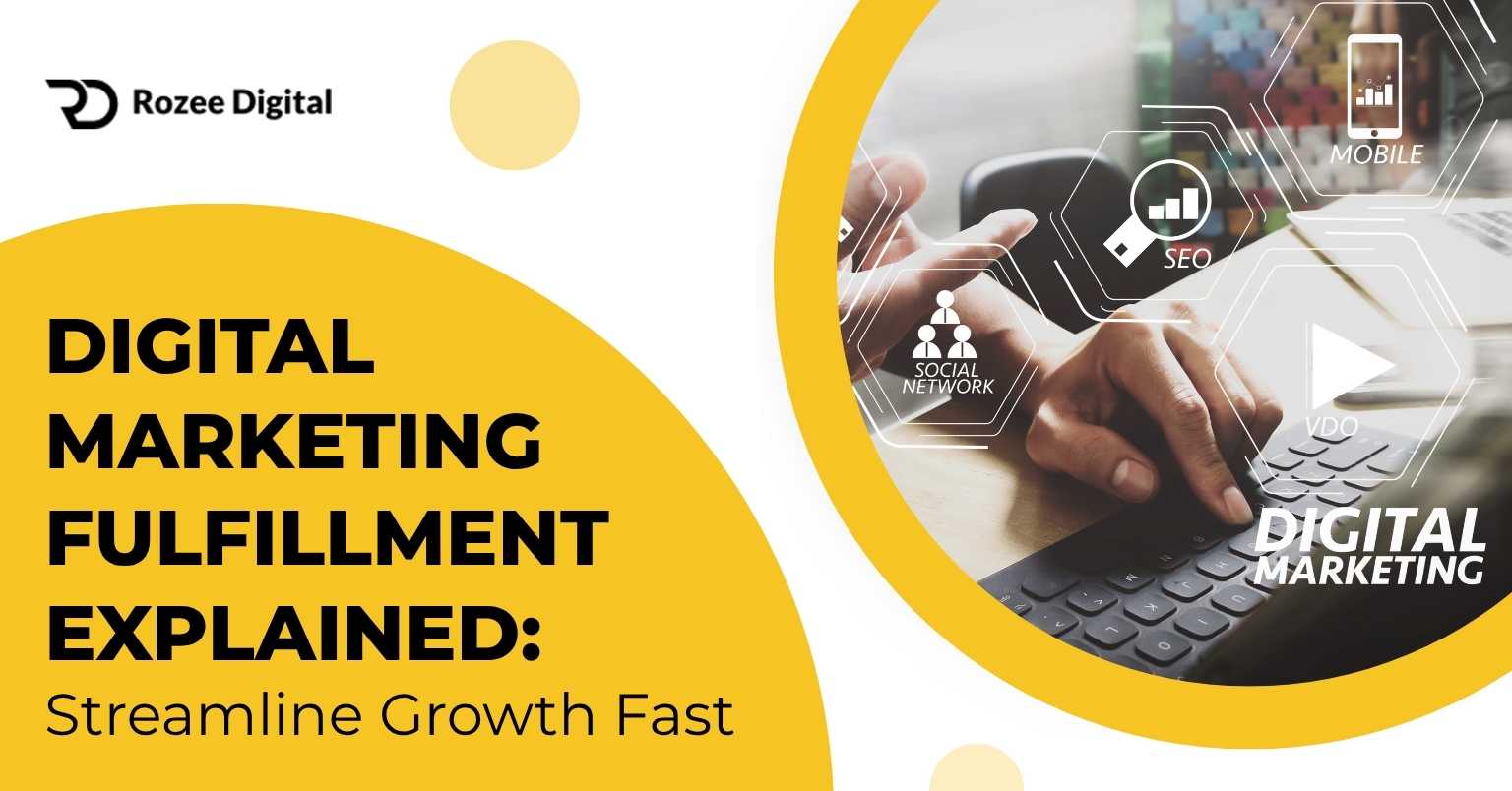Most businesses lose potential customers without even knowing it. Sopro research from 2024 shows that 96% of website visitors aren’t ready to buy on their first visit. They’re just browsing, learning, and comparing options. Without a proper funnel, these people disappear forever.
This is exactly why learning how to build a digital marketing funnel changes everything. A funnel guides people from first discovery to final purchase systematically. It nurtures relationships and builds trust over time. The right funnel turns strangers into loyal customers predictably.
This guide walks you through creating a high-converting funnel from scratch. We’ll cover every stage, share real examples, and give you actionable steps. No confusing theory. Just proven strategies that work for real businesses.
🚀 Ready to build a funnel that actually converts? Book your free growth call with Rozee Digital today at +447887880993 and start turning visitors into loyal customers.
The Core Marketing Funnel Stages Every Business Needs
All effective funnels follow the same basic structure. Understanding each stage helps you create content and campaigns that move people forward naturally.
Top of Funnel Awareness Stage
This is where people first discover your brand. They don’t know you exist yet. Your goal is getting on their radar through helpful content and targeted advertising.
Awareness content educates without selling. Blog posts, videos, social media, and podcasts all work here. You’re solving problems and answering questions. Selling comes later after trust builds.
Traffic sources for awareness include organic search, social media, display ads, and content discovery platforms. You’re casting a wide net. Most people aren’t ready to buy yet and that’s completely fine at this stage.
The key metric here is reach and traffic volume. How many new people are discovering your brand monthly? Track new website visitors, social media followers, and email subscribers. These are your funnel fuel.
Middle of Funnel Consideration Stage
Now people know about you but haven’t decided to buy yet. They’re comparing options and evaluating whether your solution fits their needs. This stage builds trust and preference.
Consideration content demonstrates value and addresses objections. Product comparisons, case studies, customer testimonials, and detailed guides work well. You’re proving you’re the best choice.
Lead magnets capture contact information at this stage. Free guides, templates, calculators, or discount codes work. Once you have their email, you can nurture them systematically toward purchase.
Email sequences are essential for this stage. Automated series educate prospects over days or weeks. Each email provides value while subtly moving them closer to buying. This is where digital funnel strategies really prove their worth.
Bottom of Funnel Decision Stage
People at this stage are ready to buy. They just need final reassurance or a small push. Your goal is making purchase easy and removing final obstacles.
Decision stage content includes product pages, pricing information, and clear calls to action. Urgency elements like limited-time offers or low stock warnings work here. Make buying feel obvious and risk-free.
Retargeting ads bring people back at this stage. They visited your product pages but didn’t buy. Remind them what they’re missing. Show social proof or offer free shipping. Small incentives convert fence-sitters.
The checkout experience matters enormously here. Complicated processes lose sales instantly. Guest checkout, multiple payment options, and trust badges all reduce friction. Every removed obstacle increases conversion rates.
Post Purchase Retention Stage
The funnel doesn’t end at purchase. Turning customers into repeat buyers and advocates is the most profitable stage. Retention generates more revenue than acquisition long-term.
Post-purchase emails keep customers engaged. Order confirmations, shipping updates, and usage tips all maintain connection. You’re building relationships, not just completing transactions.
Loyalty programs encourage repeat purchases. Points, discounts, or VIP tiers reward customers for coming back. Repeat customers spend more and cost less to serve. They’re your most valuable asset.
Referral programs turn customers into promoters. Happy customers will recommend you if asked. Incentivize referrals with discounts or credits. This creates a self-sustaining growth loop.
7 Steps to Build Marketing Funnel That Actually Converts
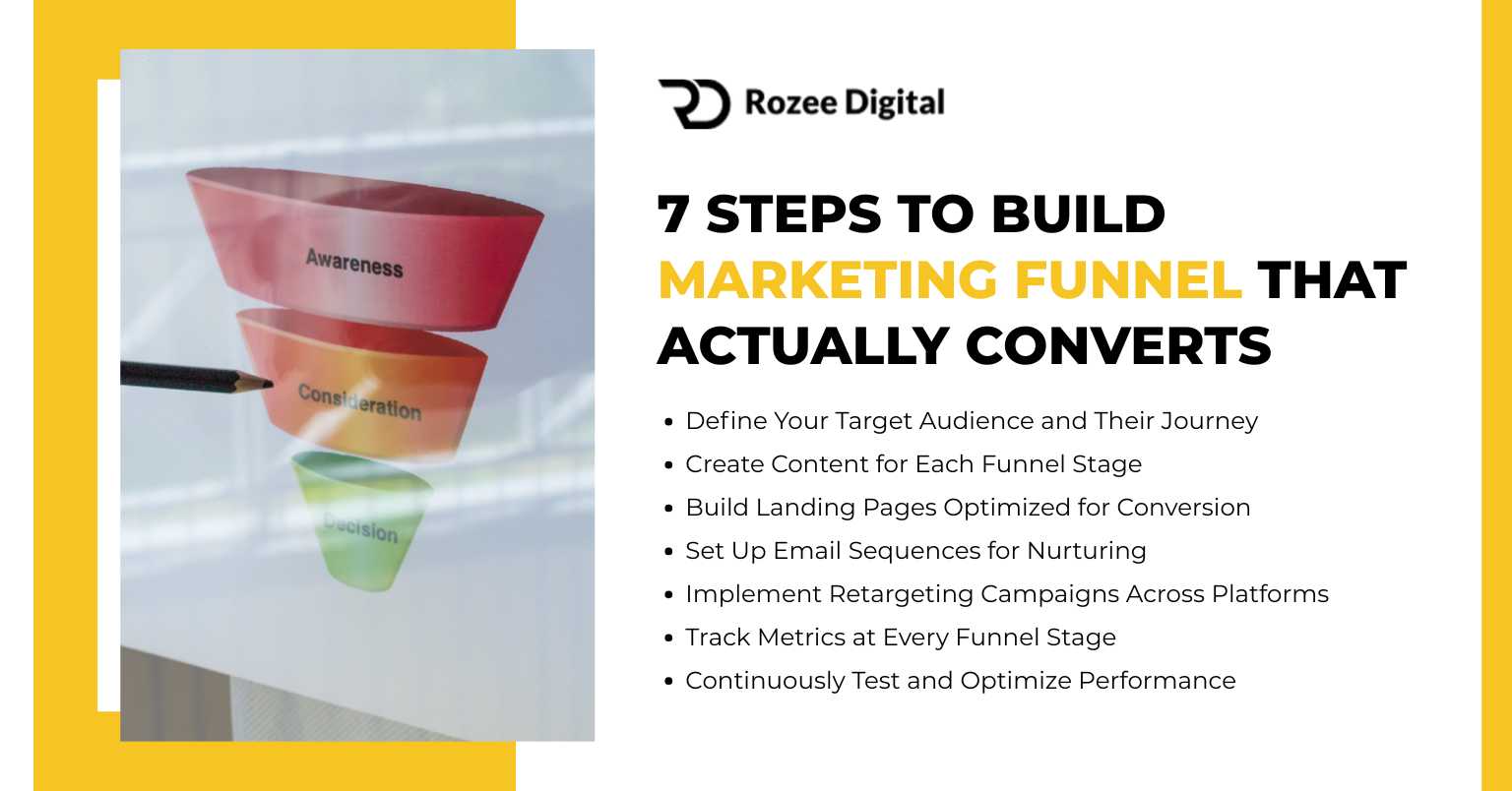
Creating your funnel doesn’t require complex technology or huge budgets. Follow these steps systematically to build a funnel that drives real business growth.
- Define Your Target Audience and Their Journey
- Create Content for Each Funnel Stage
- Build Landing Pages Optimized for Conversion
- Set Up Email Sequences for Nurturing
- Implement Retargeting Campaigns Across Platforms
- Track Metrics at Every Funnel Stage
- Continuously Test and Optimize Performance
Step 1: Define Your Target Audience and Their Journey
Everything starts with understanding who you’re selling to. Generic marketing to everyone wastes money. Specific messaging to defined audiences converts much better.
Create detailed customer personas. Include demographics, pain points, goals, and buying behaviors. What problems do they need solved? What objections do they have? Where do they spend time online?
Map out their typical buyer journey. How do they currently discover products like yours? What research do they do? How long does their decision process take? Understanding this path shows where to reach them.
Identify the questions they ask at each funnel stage. Awareness stage questions differ from decision stage questions. Create content answering the right questions at the right time. This alignment dramatically improves conversion rates.
Ready to pinpoint your ideal audience and craft messages that convert? Partner with Rozee Digital to build data-driven strategies that deliver real results.
Step 2: Create Content for Each Funnel Stage
Content is the fuel that moves people through your funnel. But different stages need different content types. Awareness content educates while decision content sells.
Top of funnel content should be broadly useful. Blog posts about industry topics, how-to videos, and infographics work well. Don’t mention your products yet. Just be helpful and build authority.
Middle funnel content gets more specific. Product comparison guides, customer success stories, and detailed features explanations fit here. You’re showing why you’re better than alternatives.
Bottom funnel content removes final objections. Product demos, free trials, money-back guarantees, and testimonials all work. Make buying feel easy and risk-free. Address every possible concern directly.
Plan a content calendar covering all stages. Most businesses only create bottom funnel content. They ignore the 98% of people who aren’t ready to buy yet. Balanced content across all stages maximizes conversion.
Step 3: Build Landing Pages Optimized for Conversion
Landing pages are where traffic becomes leads or customers. Generic homepage links don’t convert well. Dedicated focused pages convert much better.
Each landing page should have one clear goal. Capture an email, sell a product, or book a consultation. Multiple goals confuse visitors. Single-focused pages convert 2-3x better than cluttered pages.
Use clear compelling headlines that match your ad or link text. If someone clicked “Free Marketing Guide,” the landing page better offer exactly that. Message match between ad and page is critical.
Include strong social proof elements. Customer testimonials, trust badges, and statistics build credibility. First-time visitors are skeptical. Social proof overcomes skepticism and builds trust quickly.
Make your call to action obvious and prominent. Use contrasting colors and clear language. “Get Your Free Guide” works better than “Submit.” Remove distractions and make the desired action stupidly simple.
Step 4: Set Up Email Sequences for Nurturing
Email remains one of the highest ROI marketing channels. But most businesses use it poorly. Automated sequences nurture leads systematically without manual effort.
Create a welcome series for new subscribers. The first 7 days after signup are critical. Deliver your promised lead magnet immediately. Then provide additional value over several emails. Build the relationship before asking for anything.
Segment your email list by behavior and interests. People who viewed product A should get different emails than people who viewed product B. Relevant personalized content converts much better than generic blasts.
Balance educational content with promotional content. The 80/20 rule works well. Eighty percent value education. Twenty percent promotional offers. Too much selling unsubscribes people. Too little selling leaves money on the table.
Test subject lines and content consistently. Open rates and click rates vary dramatically based on messaging. Keep what works and improve what doesn’t. Small improvements compound into massive differences over time.
✉️ Want to turn email into your highest-converting channel? Explore Rozee Digital’s Email Marketing Services and discover how strategic automation and segmentation can drive consistent revenue growth.
Step 5: Implement Retargeting Campaigns Across Platforms
Most people don’t buy on their first visit. Retargeting brings them back by showing ads after they leave. This is essential for sales funnel marketing success.
Install tracking pixels on your website immediately. Facebook Pixel, Google Ads tag, and other platform pixels track visitor behavior. This data powers your retargeting campaigns across multiple platforms.
Create audience segments based on behavior. People who viewed products need different ads than people who abandoned carts. Specific messaging for specific behaviors converts much better than generic retargeting.
Show dynamic ads displaying products people actually viewed. Someone who looked at red sneakers should see red sneaker ads, not random products. Dynamic retargeting improves relevance and conversion dramatically.
Set frequency caps to avoid annoying people. Seeing your ad five times per day feels stalky. Once or twice daily maximum keeps you top-of-mind without becoming irritating. Balance persistence with respect.
Step 6: Track Metrics at Every Funnel Stage
You can’t improve what you don’t measure. Tracking conversion rates at each stage reveals exactly where to focus improvement efforts.
Use Google Analytics or similar tools to track the entire journey. Set up goals for key actions like email signups, product views, and purchases. This data shows your funnel’s strengths and weaknesses.
Calculate conversion rates between each stage. What percentage of visitors become subscribers? What percentage of subscribers become customers? These numbers reveal bottlenecks needing attention.
Track cost per acquisition at each stage. How much does it cost to get a visitor? A subscriber? A customer? This data shows whether your funnel is profitable and where to invest more.
Monitor these metrics weekly and look for trends. Are conversion rates improving or declining? Which traffic sources convert best? Regular analysis guides optimization decisions.
Step 7: Continuously Test and Optimize Performance
No funnel is perfect on the first try. Continuous testing and improvement separate good funnels from great ones. Small optimizations compound into huge results.
Use A/B testing for landing pages and emails. Test headlines, images, copy, and calls to action. Run tests long enough to get statistically significant results. Then implement winners permanently.
Identify your biggest bottleneck first. If most people leave after viewing one product page, that’s your problem. Fix the biggest leak before optimizing smaller issues. This maximizes impact from your efforts.
Survey customers to understand their experience. Ask what almost stopped them from buying. Ask what convinced them to purchase. Real customer feedback reveals issues you’d never spot in analytics.
Stay updated on new tactics and technologies. Marketing evolves constantly. What worked last year might not work now. Test new approaches regularly while maintaining proven winners.
Why Most Businesses Struggle Without a Clear Funnel
Random marketing activities waste money fast. Posting on social media without strategy. Running ads without follow-up. Creating content that doesn’t connect. These scattered efforts rarely produce consistent results.
Understanding What a Digital Marketing Funnel Actually Does
A digital marketing funnel is the path people take from discovering your brand to becoming customers. It’s called a funnel because it starts wide at the top and narrows at the bottom. Lots of people enter but fewer people buy.
Think of it like dating. You don’t propose marriage on the first date. You start with casual conversation, then coffee, then dinner, and build from there. Marketing works the same way. People need multiple touchpoints before they trust you enough to buy.
For eCommerce specifically, funnels guide visitors through awareness, consideration, and decision stages. Each stage has different content and goals. Understanding these stages is essential for learning how to create a digital marketing funnel that actually converts.
Most failed marketing happens because businesses skip steps. They try to sell immediately to cold audiences. Or they stop nurturing after the first interaction. A proper funnel keeps people moving forward at their own pace until they’re ready.
The Cost of Not Having a Structured Funnel
Businesses without funnels waste most of their marketing budget. Salesforce data shows that only 2% of sales happen on first contact. The other 98% require multiple interactions. Without a system capturing and nurturing leads, you lose that 98% permanently.
Customer acquisition costs skyrocket without proper funnels. You’re constantly chasing new cold audiences. But nurturing existing leads costs five times less than finding new ones. Funnels maximize value from every dollar spent on traffic.
Brand awareness efforts produce no revenue without conversion paths. You might get thousands of social media followers. But if there’s no system moving them toward purchase, it’s just vanity metrics. Funnels connect awareness to actual sales.
Your competitors with good funnels will always outperform you. They convert more traffic with less budget. They build customer relationships that generate repeat purchases. Without your own funnel, you’re fighting with one hand tied behind your back.
How Funnels Transform Random Marketing into Systems
Funnels create predictable revenue instead of random results. When you know your conversion rates at each stage, you can forecast revenue accurately. This lets you make better business decisions and plan growth confidently.
Systems scale easily while random activities don’t. Once you build a working funnel, you just add more traffic. The system converts that traffic automatically. This is how small teams compete with much larger competitors successfully.
Funnels reveal exactly where problems exist. Low traffic? Work on awareness. Good traffic but no conversions? Fix your offer or messaging. Clear data shows exactly what needs improvement. Random marketing leaves you guessing constantly.
Automation becomes possible with structured funnels. Email sequences, retargeting ads, and lead scoring all require funnel structure. These automations work while you sleep. They nurture thousands of leads simultaneously without manual effort.
Digital Funnel Examples from Real Successful Businesses
Seeing how other businesses structure their funnels helps you design your own. These examples show different approaches that all work effectively.
Ecommerce Store Using Content and Email Funnels
A home decor store struggled to convert cold traffic. They ran Facebook ads directly to product pages. Conversion rates stayed below 1% and customer acquisition costs were unsustainable.
They rebuilt their entire approach as a proper funnel. Top of funnel blog posts about interior design tips attracted organic traffic. Lead magnets offered free design guides in exchange for emails.
Email sequences nurtured subscribers over two weeks. Each email provided design tips while showcasing relevant products naturally. The final emails offered time-limited discount codes.
Results improved dramatically within three months. Email subscribers converted at 8% compared to 0.8% for cold traffic. Customer acquisition cost dropped 60%. Revenue increased 230% from the same ad budget.
SaaS Company Building Product-Led Growth Funnel
A project management software company offered free trials but few converted to paid plans. They had traffic but no systematic nurturing. Most trial users never fully engaged with the product.
They created an onboarding funnel guiding trial users through key features. Automated emails triggered based on user actions or inactions. If someone didn’t complete the setup, they got a helpful reminder.
In-app messages prompted users to try specific features at the right moments. This increased product engagement during trials. Engaged users converted to paid plans at much higher rates.
The funnel reduced trial-to-paid conversion time from 21 days to 7 days. Conversion rates doubled from 15% to 30%. Customer lifetime value increased because fully onboarded users stuck around longer.
Service Business Funnel Using Webinars and Consultations
A business coaching service needed qualified leads. Their website explained services but didn’t filter serious prospects from casual browsers. Sales calls with unqualified leads wasted time.
They created a webinar funnel as their primary lead source. Ads promoted free webinars teaching valuable strategies. Registration required name and email. This built their list with engaged prospects.
The webinar delivered genuine value while demonstrating expertise. The pitch at the end offered free strategy consultations. Only people impressed by the webinar requested consultations.
This funnel dramatically improved lead quality. Consultation booking rate jumped from 2% to 23% of webinar attendees. Sales conversion from consultations increased from 30% to 58%. The funnel pre-qualified and pre-sold prospects effectively.
How to Create a Digital Marketing Funnel for Different Business Types
While core principles stay the same, implementation details vary by business model. Adapt these frameworks to your specific situation.
Ecommerce Product Funnels
Ecommerce funnels focus on moving people from product discovery to purchase quickly. The consideration stage is shorter than service businesses because purchases are lower risk.
Top of funnel content includes gift guides, style tips, and product education. Blog posts and Instagram content work well. The goal is inspiring desire and showcasing products naturally.
Middle funnel uses product comparison content and customer reviews. You’re helping people decide between options. Dynamic retargeting shows products they viewed. This keeps products top-of-mind.
The bottom funnel removes purchase friction. Free shipping thresholds, easy returns, and trust badges all reduce anxiety. Cart abandonment emails recover lost sales. Urgent elements create a reason to buy now.
Post-purchase focuses on satisfaction and repeat orders. Thank you emails, usage tips, and loyalty programs keep customers engaged. Product recommendations based on purchases drive additional revenue.
Service Business and B2B Funnels
Service funnels require more nurturing because purchases are higher consideration. Trust building takes center stage. The sales cycle is longer but transaction values are higher.
Top of funnel establishes expertise through educational content. Blog posts, podcasts, and speaking engagements position you as the authority. You’re building a reputation before asking for anything.
The middle funnel demonstrates your unique approach and results. Case studies, testimonials, and detailed service explanations work well. Webinars and video content let prospects experience your teaching style.
Bottom funnel offers low-risk ways to experience your service. Free consultations, strategy sessions, or audits let people test you. These calls qualify prospects and close deals simultaneously.
Post-purchase focuses on results delivery and referrals. Happy clients become your best marketing. Asking for testimonials and referrals at the right time creates growth loops.
Digital Product and Course Funnels
Digital products have high margins but require significant trust building. Customers can’t physically touch products before buying. Social proof and guarantees overcome skepticism.
Top of funnel provides free valuable content in your topic area. YouTube videos, podcasts, and blog posts work excellently. You’re proving expertise while building audience trust.
Middle funnel offers lead magnets like free mini-courses or templates. This lets people experience your teaching style and content quality. If they like free content, they’ll consider paying a premium.
Bottom funnel uses sales pages with video sales letters. Long-form content addresses every objection. Testimonials from successful students provide social proof. Money-back guarantees remove risk.
Post-purchase delivers excellent product experience. Onboarding sequences ensure customers get value. This reduces refunds and creates advocates who promote their networks.
Common Mistakes That Kill Digital Funnel Conversion
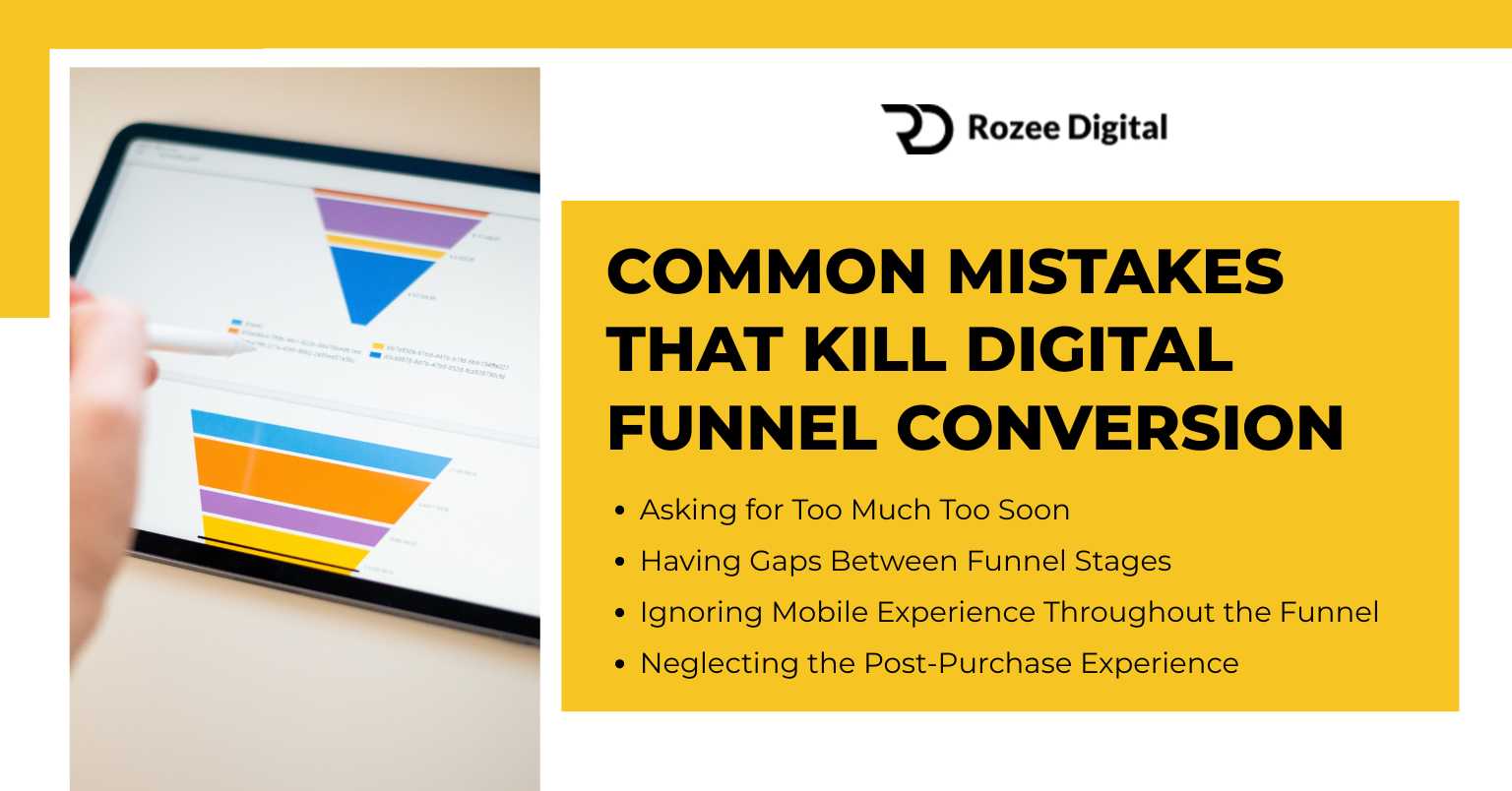
Even good funnels fail when businesses make these critical errors. Avoiding these mistakes saves time and dramatically improves results.
- Asking for Too Much Too Soon
- Having Gaps Between Funnel Stages
- Ignoring Mobile Experience Throughout the Funnel
- Neglecting the Post-Purchase Experience
Asking for Too Much Too Soon
The biggest mistake is pushing for sales too early. Cold audiences aren’t ready to buy. Aggressive selling scares people away. You lose them before building any relationship.
Each stage should ask for small progressive commitments. Awareness stage asks for attention. The consideration stage asks for an email. The decision stage asks for purchase. Appropriate asks match readiness.
Lead magnets that require too much information fail. Long forms reduce conversion rates. Ask for name and email only initially. You can gather more information later once trust builds.
Product pages for first-time visitors should be educated before selling. Explain benefits clearly. Address common questions. Reduce perceived risk. Make buying feel smart and safe, not rushed or pressured.
Having Gaps Between Funnel Stages
Disconnected stages lose people unnecessarily. Someone signs up for your email list but receives nothing for three days. They forget about you. The relationship dies before starting.
Immediate follow-up is essential. Welcome emails should arrive within minutes of signup. Strike while interest is hot. Delayed responses waste the momentum you created getting them to sign up.
Every piece of content should have clear next steps. Blog posts need email signup forms. Emails need links to relevant products. Product pages need to be added to cart buttons. Obvious paths forward keep people moving.
Retargeting should activate immediately for key behaviors. Someone who abandons a cart at 3pm should see retargeting ads by evening. Quick follow-up converts much better than delayed reminders.
Ignoring Mobile Experience Throughout the Funnel
Mobile devices drive most traffic now. Invespcro found that 55% of eCommerce traffic comes from mobile. But most businesses optimize only for desktop. This kills conversions unnecessarily.
Every funnel element must work perfectly on mobile. Landing pages should load fast and look great on small screens. Forms should be easy to complete with thumbs. Checkout must work smoothly.
Email design matters enormously on mobile. Walls of text don’t work. Short paragraphs, clear headlines, and obvious buttons convert better. Preview your emails on actual phones before sending.
Retargeting ads need mobile-specific creativity. What works on desktop often fails on mobile. Test ad formats and sizes specifically for mobile placements. Don’t just shrink desktop ads.
Neglecting the Post Purchase Experience
Most businesses stop marketing after the sale. This is incredibly shortsighted. Repeat customers deliver the most long-term profit. Retention is easier and cheaper than acquisition.
Post-purchase emails should continue nurturing. Order confirmations, shipping updates, and product tips maintain engagement. You’re building a relationship, not ending it at checkout.
Request reviews and testimonials at the right time. After customers receive products and use them briefly. Make requesting feedback easy with simple one-click systems. These testimonials fuel your funnel.
Loyalty programs incentivize repeat purchases. Points, tiers, or exclusive offers reward customers for coming back. Build systems that turn one-time buyers into lifelong customers.
Tools and Technology to Build Your Funnel Fast
You don’t need expensive complicated tools to start. But the right technology makes implementation easier and scaling possible.
Email Marketing Platforms for Automation
Email marketing software is essential for funnel success. Platforms like Mailchimp, Klaviyo, and ConvertKit automate nurturing sequences. They segment audiences based on behavior.
Look for platforms offering automated sequences and segmentation. Basic broadcast email isn’t enough. You need behavior-triggered automation sending the right message at the right time.
Integration with your website and ecommerce platform matters. Tracking purchases and browsing behavior enables powerful personalization. Everything should connect and share data seamlessly.
Start with user-friendly platforms even if they have fewer features. Learning complicated enterprise software wastes time. Simple tools used well beat complex tools used poorly every time.
Landing Page Builders and Optimization Tools
Dedicated landing page builders create high-converting pages faster than building from scratch. Unbounce, Leadpages, and Instapage offer templates and optimization features.
Templates get you started quickly but customize them to match your brand. Generic-looking pages convert worse than branded pages. Professional design builds trust.
A/B testing capabilities help you improve continuously. Test headlines, images, and calls to action. Even small improvements compound dramatically over thousands of visitors.
Mobile optimization is non-negotiable. Ensure your builder creates responsive pages automatically. Never launch pages without testing on actual mobile devices first.
Analytics and Tracking Platforms
Google Analytics is free and essential for tracking funnel performance. Set up goals for key actions. Track traffic sources and user behavior. This data guides all optimization decisions.
Heatmapping tools like Hotjar show exactly how people interact with pages. See where they click, how far they scroll, and what confuses them. Visual data reveals issues analytics miss.
Attribution platforms help understand the full customer journey. Tools like Ruler Analytics or Wicked Reports show how different touchpoints contribute to sales. Multi-touch attribution reveals true campaign performance.
Conversion optimization platforms like Optimizely enable sophisticated testing. Run experiments across entire funnels. Find winning combinations of elements across multiple pages.
CRM Systems for Lead Management
Customer relationship management systems organize leads and automate follow-ups. HubSpot, Salesforce, and Pipedrive track every interaction. This prevents leads from falling through cracks.
CRMs score leads based on behavior and engagement. Hot leads get immediate attention. Warm leads get automated nurturing. This prioritization improves sales efficiency dramatically.
Integration with marketing tools creates closed-loop reporting. See which marketing sources produce best customers. This data optimizes budget allocation across channels.
Start with simple CRM systems if you’re new. Complexity can overwhelm small teams. Grow into advanced features as your needs and sophistication increase.
Measuring Success with Marketing Funnel Optimization
Building the funnel is just the start. Continuous measurement and optimization separate good funnels from great ones. Track these key metrics systematically.
Core Funnel Metrics That Actually Matter
Conversion rate at each stage is your most important metric. What percentage of visitors become subscribers? What percentage of subscribers become customers? These rates reveal bottleneck locations.
Time to conversion shows how long the journey takes. Shorter is usually better but varies by industry. Tracking this helps you understand natural buying timelines.
Cost per acquisition tells you if your funnel is profitable. Include all costs: ads, tools, content creation. Compare this to customer lifetime value. Healthy ratios indicate sustainable growth.
Customer lifetime value predicts long-term profitability. How much does an average customer spend over their relationship with you? This number determines how much you can afford for acquisition.
Setting Up Proper Attribution Tracking
Multi-touch attribution reveals the full customer journey. First-click attribution shows initial discovery sources. Last-click shows what closed the sale. Both matter but tell different stories.
Use UTM parameters on all marketing links. This tracks exactly which campaigns drive which results. Without proper tagging, you’re blind to performance.
Set up conversion tracking in all ad platforms. Facebook, Google, and other platforms need to know what converts. This data powers their optimization algorithms.
Review attribution reports monthly. Understand which channels assist versus close sales. This prevents cutting campaigns that look unprofitable under last-click but actually contribute significantly.
Creating Dashboards for Quick Decision Making
Build simple dashboards showing key funnel metrics. You should see performance at a glance. Complicated reports that take hours to understand don’t get used.
Update dashboards automatically whenever possible. Manual reporting wastes time. Automated dashboards using tools like Google Data Studio or Tableau save hours weekly.
Share dashboards with your entire team. Everyone should understand funnel performance. Transparency aligns teams around shared goals and priorities.
Review dashboards weekly and look for trends. Are conversion rates improving or declining? Which stages need attention? Regular reviews catch problems early before they become crises.
Want to boost your funnel performance even further? Read our guide on Conversion Rate Optimization for eCommerce to learn proven tactics that turn insights into higher conversions.
Key Takeaways for Building Your Converting Funnel
Creating effective funnels transforms marketing from expense to investment. These principles guide successful implementation regardless of your business type.
Start with your customer journey, not your product features. Understand where people are and what they need at each stage. Then create content matching those needs.
Build content for every funnel stage systematically. Most businesses over-invest in the bottom funnel and ignore awareness. Balanced content across all stages maximizes conversion.
Use email automation to nurture relationships over time. Automated sequences work while you sleep. They deliver personalized value at scale impossible manually.
Implement retargeting across multiple platforms. Bring people back who showed interest but didn’t convert. Retargeting dramatically improves overall funnel performance.
Track everything and optimize continuously. Measure conversion rates at each stage. Fix biggest bottlenecks first. Small improvements compound into massive results.
Remember that funnels need time to mature. Don’t expect perfect results immediately. Build, measure, learn, and improve systematically. Patience and persistence win.
Ready to build a high-converting funnel that drives consistent, predictable growth? Rozee Digital helps eCommerce brands design and implement complete digital funnel strategies with a data-driven approach that maximizes ROI.
Book your free strategy call today at +447887880993 and start optimizing every stage of your funnel for measurable results.
FAQs
Q.1: How long does it take to build a digital marketing funnel?
A basic funnel takes 2-4 weeks to set up initially. Full optimization takes 3-6 months as you collect data and test improvements systematically.
Q.2: What are the essential marketing funnel stages?
The core stages are awareness, consideration, decision, and retention. Each stage needs specific content and strategies matched to customer readiness levels.
Q.3: How much does building a funnel cost?
Basic funnels cost $1,000-5,000 using affordable tools. Advanced funnels with custom development cost $10,000-50,000. Most businesses start simple and expand over time.
Q.4: What tools do I need to create a sales funnel?
Essential tools include email marketing software, landing page builder, analytics platform, and CRM system. Many affordable options exist for businesses of all sizes.
Q.5: How do I know if my funnel is working effectively?
Track conversion rates between each stage and cost per acquisition. Compare customer acquisition cost to lifetime value. Profitable ratios indicate funnel success.

